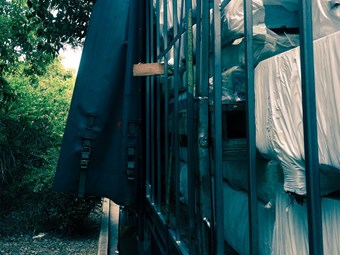NSW Authorities Ground 11 Trucks during Compliance Operation in Sydney

Authorities grounded 11 trucks on the spot, including this one which had items protruding from the side of the load.
Source: FullyLoaded.com.au
NSW Road Authorities recently conducted an operation which yielded some disturbing results. The officials involved in ‘Operation Containment’ expressed their shock at the discovery of a number of maintenance and loading issues.
As a result of the operation, 11 trucks were grounded, one of which had items protruding out from the side of the load.
The 5 day long compliance operation that happened across Sydney involving officers from Roads and Maritime Services (RMS) and New South Wales Police resulted in almost 700 heavy vehicles being checked at Wetherill Park and Botany.
Authorities say they found hundreds of issues including some so severe that the vehicles had to be immediately grounded. Twelve heavy vehicles were issued fines for weight breaches.
The joint taskforce conducting the operation described the results as “shocking” with 13 trucks being given formal warnings to attend to potential maintenance problems.
Some of the other commonly occurring breaches discovered by authorities include poorly loaded vehicles and unsecured or improperly secured cargoes.
Some trucks had their loads adjusted after inspection and 286 had minor defects for load restraint.
In an article on Fullyloaded.com.au RMS director of safety and compliance Peter Wells said that one of the grounded heavy vehicles was pulled over with items visibly protruding from its side. It also had several metal bars not properly secured on the trailer and faulty brakes.
Mr Wells explained how concerning these issues are, particularly because these people transport loads for a living, they should be more serious about safety. He stated:
“It is very difficult to understand how someone who transports these types of loads for a living could be so blasé about safety,” he says.
Source: http://www.fullyloaded.com.au
Authorities also found 8 instances of speed limiter tampering. One truck apparently had its’ limiter adjusted to allow it to drive up to 150km/hr.
Even more of a concern, are those vehicles which demonstrated a combination of compliance issues. Mr Wells explained:
“Overloading, excess speed and poorly maintained trucks are a deadly combination,”
“It’s not really a question of if, but when a truck carrying too much weight, travelling too fast and with dangerous brakes, or other maintenance issues will come to a ‘dead’ stop.
“Rogue operators should understand the taskforce will do everything in its power to change the culture of unsafe practices on the roads.”
Source: http://www.fullyloaded.com.au
While authorities described the results of the operation as “shocking”, the ATA NSW believes that some parts of the operation have been overemphasized.
Speaking on behalf of the organisation manager Jodie Broadbent stated:
“Many of the original equipment manufacturers’ (OEM) original settings are correct, but assume all elements of the speed limiting device are working,” she says.
“When combined with a faulty vehicle speed sensor, for example, this can mean it is possible to increase speed, but the vehicle may never have done that.”
Source: http://www.fullyloaded.com.au
She says authorities should charge anyone they suspect of deliberately tampering with limiter devices but if there are electronic anomalies with no evidence of speeding, this amounts to a minor defect which would allow the driver to continue with their task with the requirement that settings be adjusted within a set time period. She explained:
“Defecting and grounding trucks until they can get a certificate from the OEM costs time and money,” she says.
“And there is no recourse for the operator if it turns out the speed limiter settings were not deliberately altered to access illegal speeds (authorities can view speeds through the engine control module).
“When this occurs, a minor defect would be more appropriate.”
Source: http://www.fullyloaded.com.au
When it comes to compliance and road safety, everyone in the chain has a part to play. It is important that everyone involved knows what it expected of them according to the law. To find out more about Chain of Responsibility compliance and legislation, click here.



